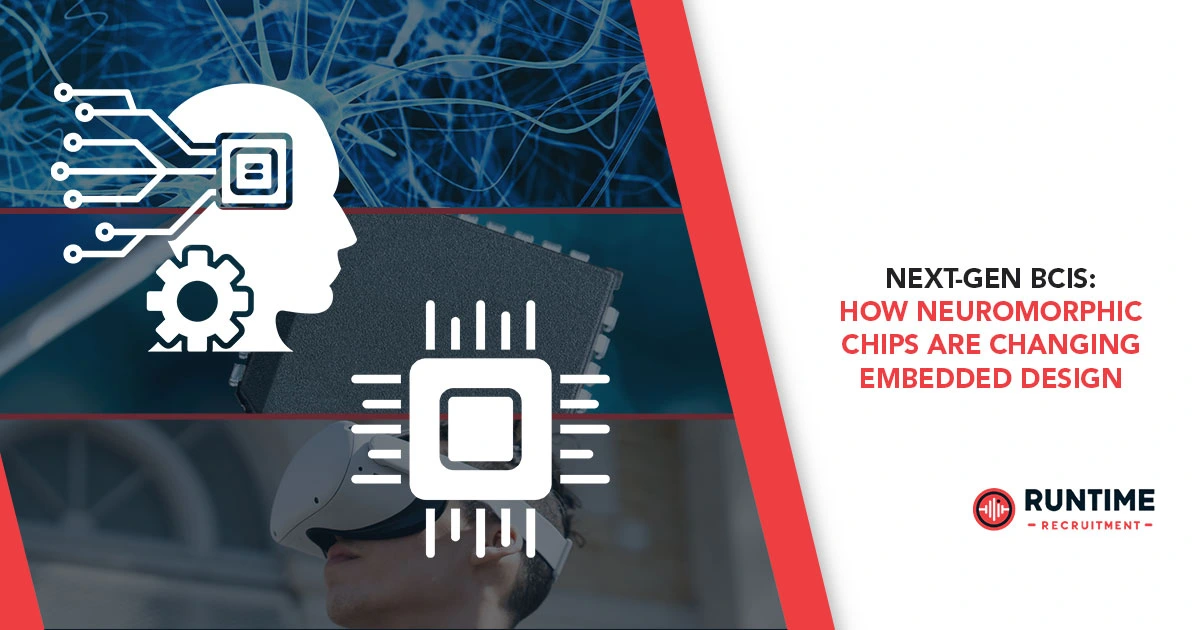The human brain, a marvel of biological engineering, processes information with unparalleled efficiency, adaptability, and low power consumption. For decades, engineers have dreamt of harnessing this biological blueprint to create machines that can seamlessly interface with and understand the intricacies of our neural activity.
This dream is rapidly evolving into a tangible reality with the advent of Brain-Computer Interfaces (BCIs), especially when coupled with the revolutionary power of neuromorphic chips. For embedded engineers, this convergence represents not just an exciting new frontier but a fundamental shift in design paradigms.
The Evolution of BCIs: From Science Fiction to Clinical Reality
Early BCIs, often seen as the stuff of science fiction, relied on bulky external equipment and rudimentary signal processing. Think of early prosthetic limbs controlled by muscle twitches or simple EEG-based communication systems. While groundbreaking for their time, these systems were limited by several factors:
- Computational Intensity: Processing raw neural data is incredibly demanding. Traditional von Neumann architectures, with their separation of processing and memory, struggle to keep up with the sheer volume and speed of neural signals.
- Power Consumption: The continuous operation of complex algorithms for real-time neural decoding consumes significant power, making true portability and long-term implantation challenging.
- Latency: The delay between thought and action in early BCIs was often noticeable, hindering natural interaction and precise control.
- Form Factor: The need for external computers and extensive wiring made these systems cumbersome and less practical for everyday use.
Despite these challenges, BCIs have made significant strides, particularly in medical applications. We’ve seen incredible advancements in restoring communication to “locked-in” patients, controlling advanced prosthetics, and even modulating neural activity for therapeutic purposes. However, to truly unlock the potential of BCIs – to make them ubiquitous, seamless, and powerful enough for a wide range of applications beyond clinical settings – a fundamental rethink of the underlying hardware was necessary.
The Neuromorphic Revolution: Mimicking the Brain’s Architecture
Enter neuromorphic computing. Unlike traditional chips designed around the von Neumann architecture, neuromorphic chips are engineered to mimic the structure and function of the human brain. This isn’t just a clever analogy; it’s a profound architectural departure.
At the heart of neuromorphic computing are artificial neurons and synapses that process and store information in an integrated fashion, much like their biological counterparts. Key characteristics include:
- In-Memory Computing: Processing occurs directly where the data is stored, eliminating the constant data transfer between CPU and memory that plagues von Neumann architectures. This dramatically reduces energy consumption and improves speed.
- Event-Driven Processing (Spiking Neural Networks – SNNs): Instead of continuous clock cycles, neuromorphic chips operate based on “spikes” – discrete events triggered when a neuron’s activation reaches a certain threshold. This asynchronous, event-driven nature is highly energy-efficient, as only active neurons consume power.
- Massive Parallelism: Neuromorphic chips feature thousands, even millions, of interconnected “cores,” each containing numerous neurons and synapses. This parallelism allows them to process vast amounts of data simultaneously, mirroring the brain’s distributed processing power.
- Learning and Adaptability: Many neuromorphic architectures are designed for on-chip learning, allowing them to adapt and improve their performance over time, much like biological brains learn from experience.
- Fault Tolerance: The distributed nature of processing means that if a few “neurons” or “synapses” fail, the system can often continue to function, exhibiting a degree of robustness inherent in biological systems.
Pioneering efforts by companies like Intel (with Loihi) and IBM (with TrueNorth) have demonstrated the viability and incredible potential of this technology. These chips are not general-purpose processors; they are specialized engines optimized for specific tasks, particularly those involving pattern recognition, anomaly detection, and real-time sensory data processing – precisely the requirements for advanced BCIs.
The Convergence: How Neuromorphic Chips Transform Embedded BCI Design
The integration of neuromorphic chips into BCI design is not merely an incremental improvement; it’s a paradigm shift for embedded engineers. Here’s how:
1. Unprecedented Power Efficiency
This is arguably the most significant advantage. Traditional BCIs require substantial power, often limiting them to tethered or short-duration battery operations. Neuromorphic chips, with their event-driven, in-memory computing, can perform complex neural decoding and signal processing at milliwatt levels.
- Implications for Embedded Design: This enables truly implantable and long-lasting BCIs without the need for frequent battery replacements or bulky external power sources. It paves the way for always-on neural monitoring, continuous prosthetic control, and chronic therapeutic interventions. Embedded engineers will focus on ultra-low-power component selection, efficient power management ICs, and innovative energy harvesting solutions to complement the chip’s inherent efficiency.
2. Real-Time, Low-Latency Processing
Neural signals change rapidly, and any delay between a user’s intent and a BCI’s response can be detrimental, especially in control applications. The parallel, in-memory processing of neuromorphic chips drastically reduces latency.
- Implications for Embedded Design: Sub-millisecond response times become achievable, leading to a more natural and intuitive user experience. This is critical for applications like high-dexterity prosthetic control, direct neural communication, and closed-loop neuromodulation systems. Embedded engineers will need to design robust communication interfaces, optimize data pipelines, and ensure the entire system maintains this low-latency characteristic.
3. On-Device Learning and Adaptability
The brain is constantly learning and adapting. Neuromorphic chips, with their inherent ability to perform on-chip learning, can enable BCIs to do the same. This means a BCI can personalize itself to an individual user’s neural patterns and adapt to changes in their brain activity over time.
- Implications for Embedded Design: This significantly reduces the need for frequent recalibration and external computational resources for model updates. The embedded system becomes more autonomous and user-centric. Embedded engineers will be tasked with designing robust firmware for on-chip learning algorithms, managing model updates securely, and implementing mechanisms for continuous adaptation while ensuring system stability. This moves away from static, pre-trained models to dynamic, evolving systems.
4. Miniaturization and Integration
The compact nature of neuromorphic chips, combining processing and memory, allows for significantly smaller footprints compared to traditional CPU/GPU-based systems.
- Implications for Embedded Design: This facilitates the creation of truly miniaturized, fully implantable BCIs. Imagine a BCI the size of a grain of rice, capable of sophisticated neural decoding. This opens doors for less invasive surgical procedures and discrete, everyday use. Embedded engineers will be at the forefront of designing custom PCBs, selecting miniature components, and implementing advanced packaging techniques to capitalize on this miniaturization, ensuring biocompatibility and long-term reliability for implantable devices.
5. Enhanced Robustness and Fault Tolerance
The distributed, parallel processing of neuromorphic architectures means that the failure of a few neurons or synapses doesn’t necessarily lead to catastrophic system failure. This “graceful degradation” is a hallmark of biological systems.
- Implications for Embedded Design: For critical medical applications, this inherent fault tolerance adds a crucial layer of safety and reliability. Embedded engineers will design systems that leverage this property, potentially implementing redundancy at a higher level and developing sophisticated error detection and correction mechanisms that work in concert with the neuromorphic chip’s capabilities.
New Challenges and Opportunities for Embedded Engineers
While neuromorphic chips offer immense promise, they also introduce a new set of challenges and exciting opportunities for embedded engineers:
1. Programming and Toolchains
Neuromorphic programming is fundamentally different from traditional imperative programming. Engineers will need to become proficient in new paradigms, often involving Spiking Neural Networks (SNNs) and specialized event-driven programming models.
- Opportunity: This is a chance to acquire cutting-edge skills in a rapidly evolving field. Expertise in SNN frameworks, neuromorphic simulators, and specialized development environments will be highly sought after.
2. Hardware-Software Co-Design
Optimizing a BCI with a neuromorphic chip requires deep understanding of both the hardware architecture and the neural algorithms running on it. Engineers will need to engage in tight hardware-software co-design to extract maximum performance and efficiency.
- Opportunity: This fosters a holistic approach to design, where embedded engineers collaborate closely with neuroscientists, AI researchers, and chip designers to create truly optimized systems.
3. Data Acquisition and Pre-processing
While neuromorphic chips excel at processing the complex patterns of neural data, the raw acquisition of these signals (from EEG, ECoG, or even invasive microelectrode arrays) remains a critical embedded challenge. Designing ultra-low-noise, high-resolution ADCs and robust front-end amplification stages is paramount.
- Opportunity: Innovation in miniature, low-power analog front-ends and secure wireless data transmission protocols will continue to be vital components of BCI systems.
4. Biocompatibility and Reliability for Implants
For implantable BCIs, the embedded system must not only function flawlessly but also coexist safely with biological tissue for years. This involves selecting biocompatible materials, designing hermetic seals, and ensuring long-term stability in the harsh environment of the human body.
- Opportunity: Expertise in medical device design principles, sterile manufacturing processes, and rigorous testing for long-term reliability will be invaluable.
5. Security and Privacy
Neural data is arguably the most sensitive personal information. Ensuring the security and privacy of this data, especially in wireless and implantable BCIs, is a non-negotiable requirement.
- Opportunity: Embedded engineers will play a crucial role in implementing robust encryption, secure boot processes, and access control mechanisms directly on the BCI hardware, safeguarding patient data from unauthorized access.
Beyond Medical: The Future Landscape of Neuromorphic BCIs
While medical applications are currently leading the charge, the advancements driven by neuromorphic chips will undoubtedly spill over into other domains:
- Enhanced Human-Machine Interaction: Imagine controlling complex machinery, virtual reality environments, or even smart home devices directly with thought, with unparalleled responsiveness.
- Cognitive Augmentation: While speculative, the potential for BCIs to assist with memory, focus, or even learning by interfacing with neuromorphic systems could unlock new forms of cognitive enhancement.
- Advanced Robotics: Neuromorphic BCIs could allow for more intuitive and natural control of robotic systems, bridging the gap between human intention and robotic action.
- Gaming and Entertainment: Imagine fully immersive gaming experiences where your thoughts directly influence the game world.
Conclusion: A New Era for Embedded Innovation
The fusion of Brain-Computer Interfaces and neuromorphic chips represents one of the most exciting and transformative frontiers in embedded engineering today. It’s a field ripe with challenges that demand innovative solutions and opportunities that promise to redefine human-computer interaction and medical technology.
Embedded engineers entering this space will not just be building components; they will be designing the very bridges between human thought and the digital world, creating devices that are more intuitive, powerful, and intimately connected to us than ever before. This journey requires a blend of traditional embedded expertise with a willingness to embrace new architectures, programming paradigms, and interdisciplinary collaboration. The next generation of BCIs, powered by neuromorphic intelligence, is not just coming – it’s already here, demanding the ingenuity and skill of the embedded engineering community.
Ready to shape the future of embedded BCI design?
Connect with RunTime Recruitment today to explore exciting career opportunities in this groundbreaking field!









